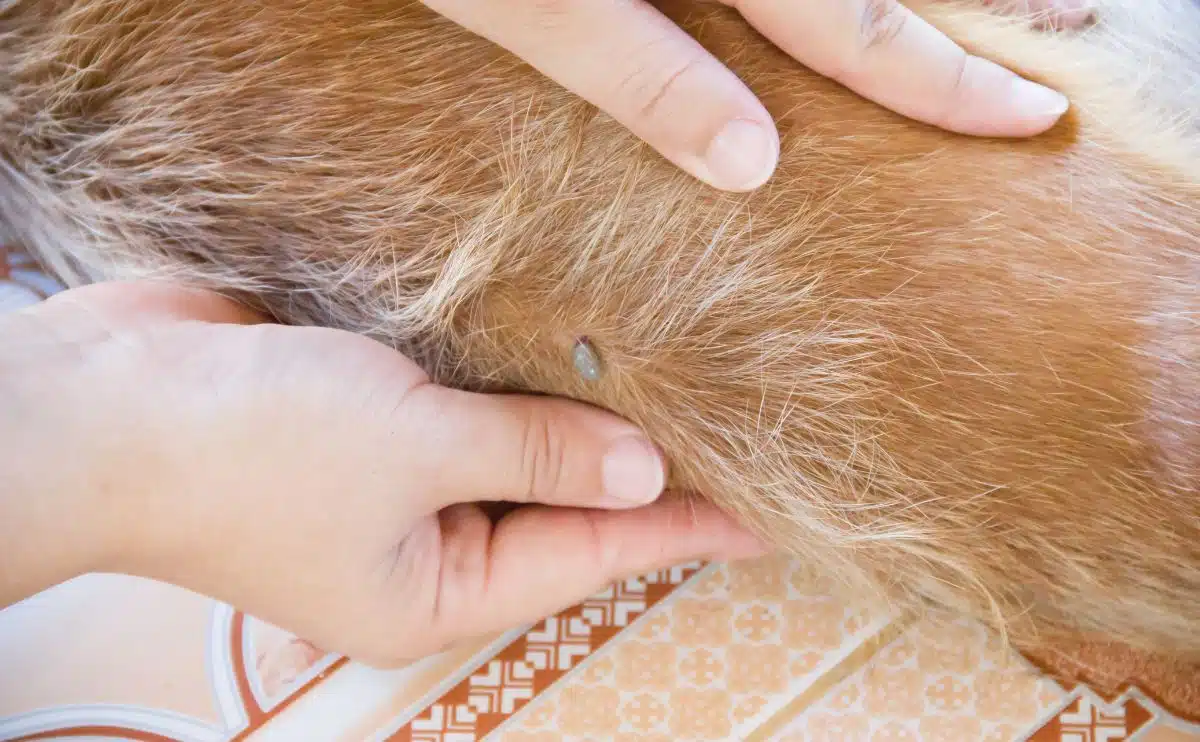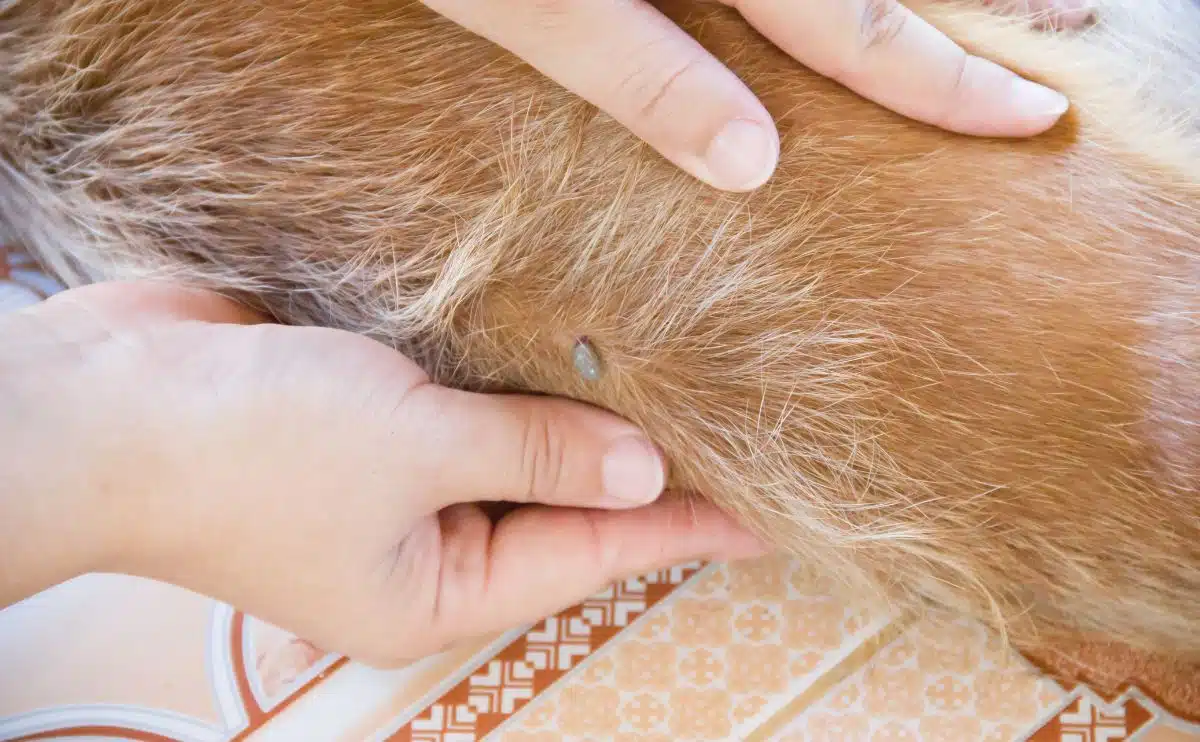
To keep the lights on, we receive affiliate commissions via some of our links. Our review process.

Our canine friends can play host to a whole variety of unwanted critters, and there are very few dogs that don’t come into contact with parasites during their lifetime. One of the most common types of parasites our dogs are exposed to is fleas. Even the thought of them makes us itch, but apart from being one of the less favored parts of pet ownership, what happens if your dog develops more serious skin conditions as a result of flea bites? This article will explore everything you need to know about flea allergies in dogs, from how they start to treatment and prevention.
What Is Flea Allergic Dermatitis In Dogs?
Contents
Fleas are the most common external parasite found on pet dogs and cats worldwide and are a common cause of itching in dogs. Flea Allergy Dermatitis or Flea Allergic Dermatitis (also known as FAD) is a common skin disease that is caused if your dog’s immune system overreacts or is hypersensitive to the bite of a flea. It is thought that the allergy is to the flea saliva that is injected into your dog’s skin when the flea bites to feed. While flea bites are likely to cause itching in most dogs, not all will develop an allergy to fleas, and can result in dermatitis (skin inflammation) and skin lesions.
Adult fleas must bite a dog to feed on their blood and reproduce. As they do so, they inject a small amount of saliva into the skin of their host before falling off. It is the proteins in the flea saliva that results in itch and inflammation in dogs that are hypersensitive or allergic. This inflammatory reaction can occur quickly within 15 minutes of a flea bite, whereas other dogs will have a delayed reaction up to 48 hours later. Even a single flea bite can cause intense itching.
Signs Of Flea Allergy In Dogs
What does a flea allergy look like on a dog?
- Frequent itching and scratching
- Hair loss. This often starts around the base of the tail and back legs and can spread along the dog’s back towards his head.
- Scabs on the skin
- Skin rash (small red bumps on the skin)/ dog flea rash
- Red patches of skin or open sores
- Live fleas or flea dirt may or may not be visible
FAD can develop at any age but is more common in young dogs between the age of 6 months and 5 years. Dogs that have other known skin allergies may be more likely to also have a flea allergy as their immune system is hypersensitive.
Flea bites on dogs can be difficult to see, especially in hairy breeds, but they can appear as small, raised, red lumps that disappear within a couple of days. Most flea infestations will not cause a specific dog flea rash. However, some dogs may have a raised, red rash most visible on hairless areas of skin such as in the groin or armpits. Learn more about flea symptoms on dogs.
How Is A Flea Allergy Diagnosed?
You can easily check for evidence of fleas on your dog at home. You may be able to see adult fleas running across your dog’s skin if you part their fur, but they move quickly, and most adult fleas (up to 95%) live in the environment around your dog and only jump on your dog to feed, so they can be difficult to spot.
A better way to look for fleas on your dog is to look for flea dirt, which is essentially the poo that fleas leave behind. Use a fine comb to brush your dog’s coat close to the skin, and look for small black spots when the coat brushings are wiped on a white paper towel. These black dots can be distinguished from regular dirt as they will leave a blood smear behind on wet paper.
If you are concerned that your dog is excessively itchy or has red or sore skin, it is best to seek veterinary advice. The inflammation that results from a flea allergy can cause secondary infections of the skin that often requires medical treatment. Your vet will be able to examine your dog’s skin and may perform skin scrapes (a simple test to collect a sample of skin cells and examine them under a microscope) or swabs to look for other parasites or bacterial skin diseases.
Allergy tests performed through a blood test or intradermal allergy test may be needed for some dogs. These tests are generally quick and simple to perform and rarely require sedation or anesthesia.
I Can’t See Any Fleas On My Dog, Can They Still Have Flea Allergic Dermatitis?
Yes! Dogs that have a severe allergy to flea saliva can have a skin flare-up with the bite of a single flea. They do not need to have fleas living on them or a large flea infestation to develop dermatitis. Flea bites may still be the cause of your dog’s skin problem, even if you haven’t seen any live fleas on them.
How Is A Flea Allergy Treated?
Treatment of a flea allergy involves ridding your pet of fleas, preventing them from getting more flea bites, and treating resulting dermatitis and skin lesions.
Treat The Host & The Environment
To understand how to control fleas, we need to consider the life cycle of the flea. Every adult flea that lands on your dog and bites to feed will lay eggs. Each adult flea can lay up to 50 eggs per day. The eggs fall from your dog’s fur and land in the environment around your dog before hatching into larvae, and pupae, and then becoming adults ready to repeat the life cycle. Therefore, to gain control of fleas, we need to consider treating the environment as well as the host, as this is where most of the fleas hang out. Learn more about flea eggs.
Different Types Of Flea Treatment
There are numerous flea treatments on the market that kill adult fleas, and these are often different in different countries. They may come in the form of spot-on treatments applied to your dog’s skin, oral products, or shampoos. The drugs that are in these products all differ. Prescription preparations available from your vet are often more effective as they may contain stronger anti-parasite drugs or more modern drugs that kill fleas faster and more efficiently than products that are bought over the counter.
The speed at which flea treatments kill fleas also differs. Dogs with flea allergies benefit from fast-acting products to provide faster relief. If your dog has skin sores or severe inflammation of the skin, then topical products, such as spot-on treatments, may not be suitable. It is advised to seek veterinary advice to ensure you pick the best flea treatment for your dog.
Treat Other Animals In The Household
It is important to remember that all animals in the house need to be treated for fleas to break the flea life cycle, even if the others don’t have a flea allergy. Using a product that kills flea eggs and larvae in the environment, such as a household spray will also break this cycle faster and reduce the chance of your dog getting bitten again.
Assessment & Potential Further Treatment
Once the fleas have been eradicated, your dog may need additional treatment for skin irritation. Assessment of your dog’s skin by a vet is advised. Treatment may involve medicated shampoos, antihistamine medication to reduce itch, or anti-inflammatory medication such as steroids. A flea allergy can unbalance the normal population of bacteria that lives on your dog’s skin all the time and result in secondary bacterial infections. This may need to be treated with a course of oral antibiotics.
Home Remedies For Flea Allergic Dermatitis
Dermatitis is often very itchy and sore for dogs, and as pet owners, we want to provide immediate relief for our canine friends. A dog flea allergy home remedy is useful to help provide respite for our furry friends alongside veterinary treatments. Products applied to the skin to cool and soothe the skin can be beneficial. Even a cool bath can provide some relief, but it is important to remember that many flea products require the coat to stay dry for 48 hours after application to allow them to work. Most flea products are different so check with the manufacturer or seek veterinary advice if you are unsure.
Here are some natural products that, when applied directly to the skin, can help provide relief for our itchy canine friend:
- Oatmeal calms redness in the skin and soothes the itch.
- Vitamin E boosts the production of collagen and promotes the regeneration of skin cells. It is also a powerful antioxidant that helps protect skin cells.
- Rosemary extract has anti-inflammatory properties.
- Coconut oil moisturizes the skin and can help reduce inflammation.
- Avocado oil encourages skin collagen production and reduces inflammation.
- Hemp seed oil helps repair skin cells and reduces inflammation.
Citronella, eucalyptus, peppermint, and tea tree have all been used as natural alternatives to flea treatment and may help to repel fleas. However, they are unlikely to kill adult fleas on their own or break the flea life cycle and may be irritating to inflamed skin. While garlic and onions are sometimes reported to repel fleas, these ingredients can be toxic to dogs and should be avoided.
How To Prevent Flea Allergy In Dogs?
Preventing flea infestations is crucial to preventing recurrent FAD in dogs. As with most things, prevention is better than cure! Using regular, good-quality flea control on your pet is essential if they are known to have a flea allergy. Reducing the flea burden in the environment by ensuring all in-contact pets are treated and using environmental treatment reduces the chance of your dog getting bitten at all. Remember, even a single flea bite can cause a reaction in some dogs. There are so many flea prevention products on the market it can get confusing, so work with your vet to pick one that is best for your dog’s needs. Or try making your own DIY homemade flea prevention.
Dogs with severe flea allergies or with combined skin allergies may benefit from desensitization. Desensitization, or hypo-sensitization, is generally performed by a series of allergy injections that contain small amounts of flea saliva or other allergens, given over a prolonged period to reduce your dog’s immune response to them.
Keeping Your Dog Flea-Free
The prognosis for pets with FAD is good if flea bites are prevented. Long-term goals for managing FAD include year-round flea prevention for all pets in the household and environmental control to reduce exposure to fleas. If your dog is still itchy after treating him for fleas, or your dog has developed a rash or skin lesions, then seek veterinary advice to get them back on track as fast as possible. Learn more about how to remove fleas from dogs at home.
Tagged With: Fleas